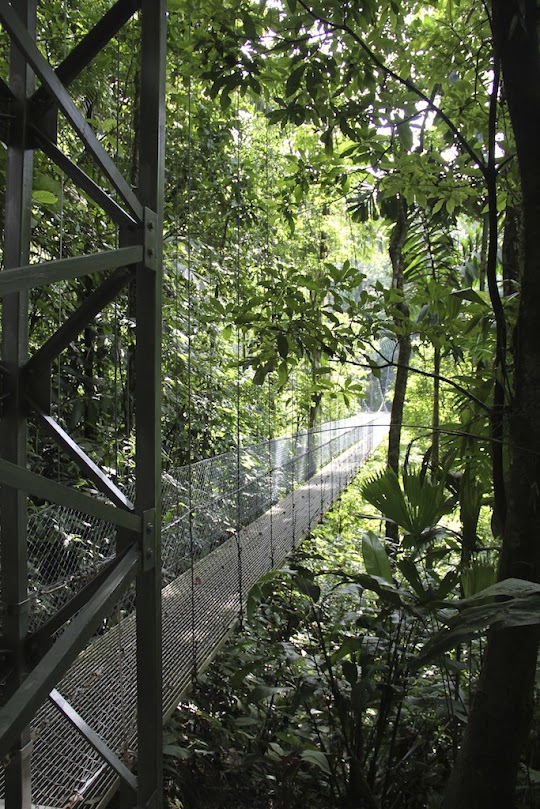Editor-in-chief Claire recently wrote about a dodgy bridge to a great little restaurant in Morocco, and it got me thinking about bridges during my recent trip to Costa Rica. Tourism is on the rise in Costa Rica. In some areas, this is totally obvious. In other areas, it’s not at all. The country is evolving—unevenly—and the bridges around the country tell this story.
Where tourists venture, infrastructure grows, and where infrastructure grows, more tourists venture. The assurance of safe and easy passage draws the larger population of semi-adventurous visitors to these developing areas. Arenal is one such place.
Arenal became a major draw when the volcano erupted in 1968 and kept on erupting until 2010. Hotels sprung up around the volcano’s base, and nearby private rain-forested land was opened to the public as a nature reserve. The galvanized steel and concrete suspension bridges, designed by civil engineers, provide “maximum security and comfort” to visitors as they traverse high above ground through the rain-forest canopy. The emphasis safety on the website reveals a need to distinguish itself from less reliable bridges found elsewhere.

On the road to Manuel Antonio, Costa Rica’s prime destination for wildlife viewing and beach dwelling, cars speed across the two-lane Rio Tarcoles Bridge, under which giant white crocodiles bathe in the muddy waters. Souvenir shops and sodas have sprouted at the bridge’s northern entrance, where you should probably go ahead and pay the guy in a neon yellow vest a few hundred colones to “watch your car.” Walk single file down the two-lane bridge where cars fly by at 100 kilometers per hour and peer over the edge at the massive beasts below. A local selling wooden crocodiles for $6 told us he’s seen these crocs attack and devour entire cows that wander over to the river’s shore in the early evening for a drink.
Off the path well beaten by the parade of tourists between Arenal and Manuel Antonio, a 4×4 will get you to the incomparably beautiful Rio Celeste. Two hours north of La Fortuna, an hour of which you’ll spend on a roughly graded gravel road, is Tenorio National Park, home of Rio Celeste, a river with a waterfall tinted a surprising shade of blue. The color of the water is a result of minerals that combine at the confluence of two water sources.
Despite its beautiful setting and the fantastic trail leading to it, Rio Celeste is relatively unvisited. A look at the bridges along the trail will tell you as much. It’s a serious pain to get to this point. It’s rugged, it’s remote, and if you’ve got a limited number of days in the country you might decide this isn’t worth the time. Good.

In ten years’ time, I’d bet good money the road to Rio Celeste is paved. Evidence of infrastructure is already apparent—leaving the area, you’ll find a new bridge that makes exiting to the west possible by car. Before last September, approaching from the west was possible only on foot. Visitors from that direction had to ditch their cars, cross a pedestrian bridge and walk the dusty road to the park entrance, or drive an additional two hours to come around from the east side.
I’ll be the first to say that I appreciate a good piece of infrastructure and the ease it creates. But this sketchy little bridge was my favorite, because it made me feel like we were in a secret place, and that we was rewarded with this secret because we put in the effort required to get there.




